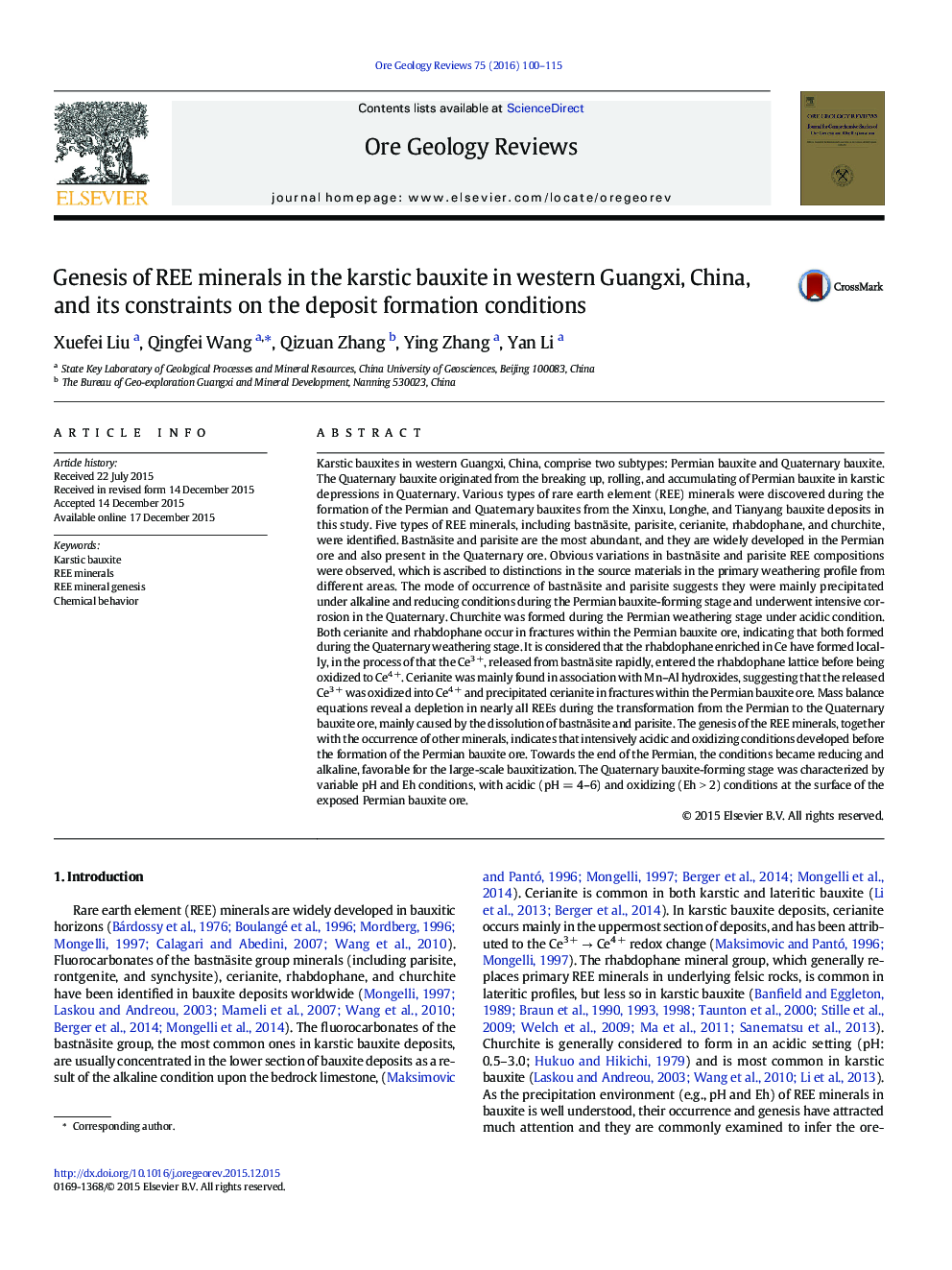| کد مقاله | کد نشریه | سال انتشار | مقاله انگلیسی | نسخه تمام متن |
|---|---|---|---|---|
| 4696896 | 1637231 | 2016 | 16 صفحه PDF | دانلود رایگان |

• Geochemical and mineralogical investigations on Xinxu, Longhe, and Tianyang bauxite deposits were conducted.
• Five REE minerals, e.g., bastnäsite, parisite, cerianite, rhabdophane, and churchite, were identified in the bauxite ores.
• Geneses of those REEs minerals and their genetic significances were discussed.
• Chemical behaviors of REEs during the transition from the Permian to Quaternary bauxite ore were evaluated.
Karstic bauxites in western Guangxi, China, comprise two subtypes: Permian bauxite and Quaternary bauxite. The Quaternary bauxite originated from the breaking up, rolling, and accumulating of Permian bauxite in karstic depressions in Quaternary. Various types of rare earth element (REE) minerals were discovered during the formation of the Permian and Quaternary bauxites from the Xinxu, Longhe, and Tianyang bauxite deposits in this study. Five types of REE minerals, including bastnäsite, parisite, cerianite, rhabdophane, and churchite, were identified. Bastnäsite and parisite are the most abundant, and they are widely developed in the Permian ore and also present in the Quaternary ore. Obvious variations in bastnäsite and parisite REE compositions were observed, which is ascribed to distinctions in the source materials in the primary weathering profile from different areas. The mode of occurrence of bastnäsite and parisite suggests they were mainly precipitated under alkaline and reducing conditions during the Permian bauxite-forming stage and underwent intensive corrosion in the Quaternary. Churchite was formed during the Permian weathering stage under acidic condition. Both cerianite and rhabdophane occur in fractures within the Permian bauxite ore, indicating that both formed during the Quaternary weathering stage. It is considered that the rhabdophane enriched in Ce have formed locally, in the process of that the Ce3 +, released from bastnäsite rapidly, entered the rhabdophane lattice before being oxidized to Ce4 +. Cerianite was mainly found in association with Mn–Al hydroxides, suggesting that the released Ce3 + was oxidized into Ce4 + and precipitated cerianite in fractures within the Permian bauxite ore. Mass balance equations reveal a depletion in nearly all REEs during the transformation from the Permian to the Quaternary bauxite ore, mainly caused by the dissolution of bastnäsite and parisite. The genesis of the REE minerals, together with the occurrence of other minerals, indicates that intensively acidic and oxidizing conditions developed before the formation of the Permian bauxite ore. Towards the end of the Permian, the conditions became reducing and alkaline, favorable for the large-scale bauxitization. The Quaternary bauxite-forming stage was characterized by variable pH and Eh conditions, with acidic (pH = 4–6) and oxidizing (Eh > 2) conditions at the surface of the exposed Permian bauxite ore.
Figure optionsDownload as PowerPoint slide
Journal: Ore Geology Reviews - Volume 75, June 2016, Pages 100–115